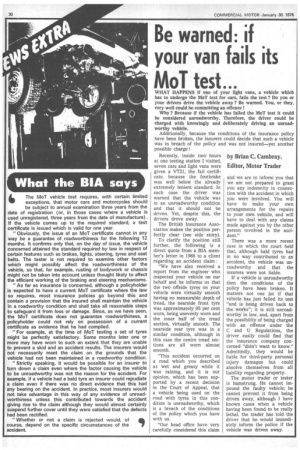Be warned: if its MoT van fails MoT test...
Page 32

If you've noticed an error in this article please click here to report it so we can fix it.
WHAT HAPPENS if one of your light vans, a vehicle which has to undergo the MoT test for cars, fails the test ? Do you or your drivers drive the vehicle away ? Be warned. You, or they, very well could be committing an offence !
Why ? Because if the vehicle has failed the MoT test it could be considered unroadworthy. Therefore, the driver could be charged with knowingly and deliberately driving an unroadworthy vehicle.
Additionally, because the conditions of the insurance policy have been broken, the insurers could decide that such a vehicle was in breach of the policy and was not insured—yet another possible charge !
by Brian C. Cambray. Editor, Motor Trader
Recently, inside two hours at one testing station I visited, seven cars and light vans were given a VT21, the fail certificate, because the footbrake was well below the already extremely lenient standard. In each case •the driver was warned that the vehicle was in an unroadworthy condition and that it should not be driven. Yet, despite this, the drivers drove away.
The British Insurance Association makes the position perfectly clear (see side story).
To clarify the position still further, the following is a direct quote from a BIA member's letter in 1968 to a client regarding an accident claim : "We have also received a report from the engineer who inspected your vehicle on our behalf and he informs us that the two offside tyres on your vehicle were virtually smooth having no measurable depth of tread, the nearside front tyre was approximately 95 per cent worn, being unevenly worn and the inner half of the tread section, virtually smooth. The nearside rear tyre was in a similar condition, although in this case the centre tread sections are all worn almost smooth.
"This accident occurred on a road which you described as wet and greasy while it was raining, and it is our opinion, which has been supported by a recent decision in the Court of Appeal, that a vehicle being used on the road with tyres in this condition is unroadworthy, which is a breach of the conditions of the policy which you have with us.
"Our head office have very carefully considered this claim and we are to inform you that we are not prepared to grant you any indemnity in connection with the accident in which you were involved. You will have to make your own arrangements for the repairs to your own vehicle, and will have to deal with any claims made against you by the other person involved in the accident."
There was a more recent case in which the court held that, although bald tyres had in no way contributed to an accident, the vehicle was unroadworthy and that the insurers were not liable.
If a vehicle is unroadworthy then the conditions of the policy have been broken. It matters not one jot if that vehicle has just failed its test "and is being driven back to the works"; it is still unroadworthy in law, and, apart from the possibility of being charged with an offence under the C and U Regulations, the driver easily could find that the insurance company concerned "didn't want to know." Admittedly, they would be liable •for third-party personal injury damages but could absolve themselves from all liability regarding property.
The motor trader or tester is hamstrung. He cannot impound the faulty vehicle; he cannot prevent it from being driven away, although I have known cases when a vehicle having been found to be really lethal, the trader has told the driver that he would immediately inform the police if the vehicle was driven away.
































































































